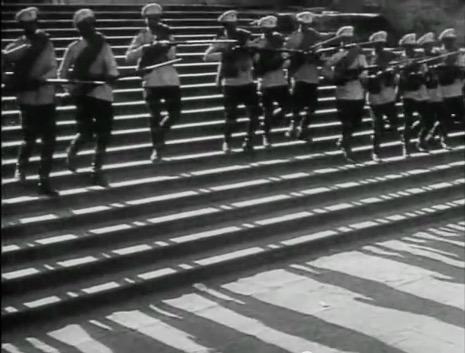Welcome to my rant about why Warhammer 40k needs a Rank and Flank rules variant.
I'd like to first to provide a roadmap to organize my thoughts:
- What is the inspiration for this within 40k?
- What is meant by Rank and Flank and what would it look like implemented in a 40k setting?
- Why do this?
What is the inspiration for this?
The largest inspiration developing a rank and flank variant of 40k is the early artwork of Rogue Trader and interviews with Rick Priestley.
In interviews Rick Priestley has discussed the inspiration for Rogue Trader and the type of civilization and warfare represented in the 40k universe. He notes that despite the relatively advanced level of technology that the imperium is a feudal civilization and the warfare represented in this setting drew heavily from this motif. He also noted that as 40k transitioned to 3rd edition that the newer rules were based on a WW2 system he had been developing outside of the office. With the introduction of IFVs and dedicated transports the game has also mirrored Cold War tactics.
 |
| I am not the first to point out this is just a bulky Soviet BMP |
And, later editions, especially with the addition of Primaris marines and hovering bradley-esque tanks has taken on a more ultra-modern aesthetic. Warhammer 40k has drawn on different eras of historical combat over time.
Are there any rules examples of Rank and Flank in 40k?
In the Rogue Trader rules there are a handful of references to primitive/medieval worlds. Similarly, Warhammer Siege explicitly contemplates mixed forces of primitive and advanced forces. However, it is never spelled out exactly how one is meant to integrate warhammer fantasy and 40k rules together.
Over the years the imperial guard have paid some homage to 19th century warfare. The 2nd third edition Imperial Guard codex has the doctrine "close order drill". This rule requires that you line up your men, base to base, to gain a leadership and initiative bonus. In 5th edition the imperial guard have various orders. One of them is called "first rank, fire! Second rank, fire!" Which allows your unit to generate more shots due to organized volley fire. This is a clear reference to 19th century military drill (likely inspired by the movie Zulu).
From a more abstract perspective, we also get hints at rank and file rules from the Apocalypse rulesets. In this ruleset the game does not adopt a rank and flank system perse, but it does introduce movement trays and a rudimentary command and control system.
What about the artwork?
Early Rogue Trader artwork had many images that are reminiscent of 19th century warfare.
The one that stands out to me the most is the cover of the imperial guard boxed set.
On this cover we see vast numbers of guardsmen lined up and marching across and open field apparently under fire. They carry banners and many carry their guns upon their shoulders.
In other versions of this image, we see officers or generals surveying the battlefield.
Again, on the front of the Eldar Legion box set we see the Eldar arrayed in a firing line with banners.
Squats in close order with banners.
Space Marines in close order with a banner.
More Elves in close order with banners.
I think you get the point. Now, we need to discuss whether these images should be taken "literally" or whether they are an aesthetic contrivance to say "hey! You're going to get a lot of minis in this box" or "look at this epic battle" - both valid interpretations. However, it also suggests that 1. rank and file formations of troops would not be aesthetically foreign to 40k and 2. If it looks epic on box art it would also look epic on the table.
We see more inspiration in the minis as well. Early RT mini ranges were filled with command groups despite the rules conspicuously lacking any role for those minis in the game.
Traditionally rank and flank table top miniature wargames emphasize formations of infantry (and other troops) moving in lines and other formations (the rank) and attempting to strategically out maneuver their opponent typically by attacking flanks (the flank).
Most simplistically, this would mean using 40k miniatures with a ruleset that borrowed heavily from the the DNA of warhammer fantasy. So we can imagine our Imperial guard and eldar arrayed in wide lines with maybe and additional rank. Our close combat troops like Orks or Hormagants organized into narrower formations with deep ranks.
We can imagine our las cannons blasting holes in units similar to cannons in warhammer fantasy. We could similarly imagine many heavy weapons converted to carriages like the original thudd gun model. Such weapons might be limbered with horses or crude tractors (gun limbering rules appeared in Gorka Morka).
What about tanks? you might ask. We might take a page out of history and consider how tanks similar to the tanks of 40k faired in real life.
Historically, tanks not entirely dissimilar to the tanks of the 40k universe have been employed by real militaries. That is, tanks with too many turrets and guns for their own good. These tanks have universally been outclassed by tanks of more focused design. The primary reason for this, to my admittedly limited knowledge, other than mechanical failures and thin armor, was command and control. Coordinating the firing of multiple weapons is mentally taxing on the commander and easily overwhelming. I haven't played current 40k, but a Rogal Dorn tank appears to have 8 weapons on it. Coordinating the tasks of 9 crew an their correspond roles/weapons would likely leave a tank commander paralyzed with too many functions screaming for their attention. Many vehicles in 40k might be similarly nerfed to allow for a game play more analogous to 19th century tactics by. That is, they could be framed as unwieldy landships that are difficult to coordinate, or lacking awareness of their surroundings. Introducing a command and control system similar to Warmaster or Apocalypse might accomplish this.
Why do this?
There are a few answers to this other than mechanical preference - many people prefer rank and flank war games because of the emphasis on maneuver, but we will set that aside and assume that preference is either self evident or not at all preferred.
The first answer is that it is more absurd. Lining up soldiers into ranks and files to fight battles with futuristic technology is absurd on its face. But, as Rick Priestley has noted, the civilization of the imperium doesn't make sense. It's not a functional society. Their society isn't justified and most of their problems are of their own design. It makes sense that the people of such a universe would be uniquely unhinged in this way. This type of game would emphasize the satire of the Warhammer universe.
 |
| An absurdist scene from King of Hearts where the British and Germans line up in close order formations before blasting each other away. |
Next, Warhammer 40k seems to have gotten smaller in the very literal sense that the standard table is technically smaller than it used to be, but also the miniatures have gotten bigger and take up more room. Combine this with infantry formations that are in loose formations and the table has become more cluttered and functionally smaller. Returning to 25/28mm scale, shrinking models down to more plausible sizes, and ranking them up would open up the table to more tactical maneuver and use of the board. This could be coupled with a change in the scale of the battles, distances could be modified - perhaps an inch could represent 10 yards like it did in Warhammer fantasy, or even farther to represent the effective range of weapons.
What do you think?





















No comments:
Post a Comment